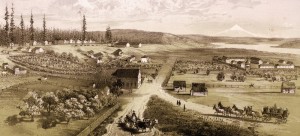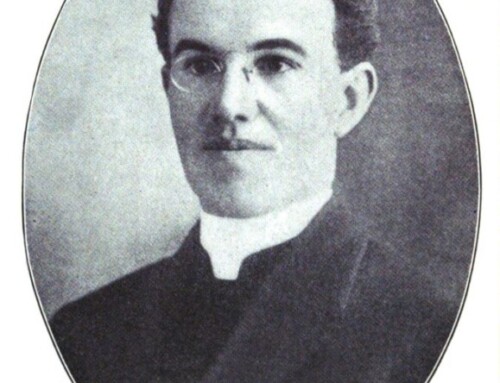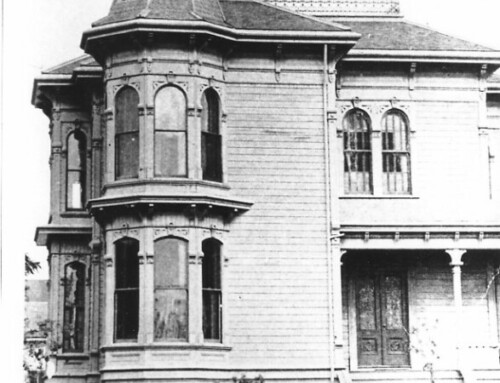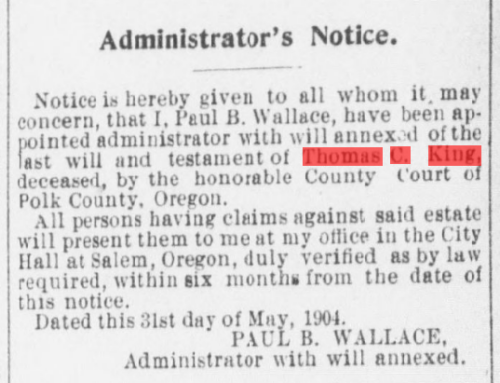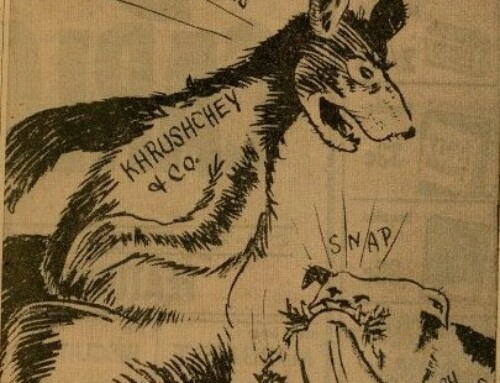Readers should feel free to use information from the website, however credit must be given to the Willamette Heritage Center and to the author of the individual articles.
Levi Jackson
In 1777, Joseph Gervais was born in Maskinonge, Canada, between Montreal and Quebec City. Gervais’ early life is obscure and little is known about him until he was twenty years of age when he left his birthplace and moved to America. Upon his arrival in the United States, Gervais took up a job in Arkansas hunting buffalo for the New Orleans market.
[1] He continued this work until 1810, when he joined the Pacific Northwest fur trade.[2]
It was in March 1810 that New York merchant John Jacob Astor signed an agreement with Alexander McKay, Donald McKenzie, and Duncan McDougall – former employees of the North West Company – to create the Pacific Fur Company. Astor also hired David Stuart and Wilson Price Hunt into the company.[3] Following the deal, Astor and his associates planned two concurrent expeditions to establish their position in the Pacific Northwest fur trade. One party was to travel by sea, headed by Duncan McDougall, and the other was to travel by land, led by Wilson Price Hunt.[4] While hunting buffalo, Gervais learned that Wilson Price Hunt was gathering men in St. Louis for the Pacific Fur Company to travel to Oregon.[5] It is unclear when and how Gervais found himself with Hunt’s land expedition, but by August 7, 1810, he is named in a Pacific Fur Company journal as part of the company.[6] In fall 1810, Hunt transported the recruited men, mostly from Montreal and Mackinac, to St. Louis. The overland party waited out the winter along the Missouri River and departed west in March, 1811.[7] It was not until January, 1812, that the first members of the expedition found themselves at the mouth of the Columbia.[8] Gervais arrived at Fort Astor on February 15, 1812.[9]
The following month a group headed by Donald McKenzie was sent to follow up on a scouting trip in the Willamette Valley. Gervais accompanied this group on their journey to the valley where he would settle later in life. The expedition explored the valley more carefully and hunted and trapped.[10] One trapper’s journal gives Gervais credit for suggesting that part of the journey was “for the purpose of establishing trade with the Indians, to instruct and encourage them to capture and properly preserve the skins of such fur bearing animals as the Company most desired.”[11]
On November 23, 1812, a group of fourteen men was sent to the Willamette Valley to establish a long-term presence and a winter trading post which came to be known as Wallace House. During the first winter months, Gervais and his friends, Louis LaBonte and Etienne Lucier, gave names to the surrounding features, such as the Pudding River (Riviere au Boudin), named for the French-Canadian dish made form elk’s blood, and Lake Labish (Lac la Biche), using their term for elk.[12]
It was not long before Gervais was hired by the English-owned North West Company. After the disappearance of the Pacific Fur Company’s supply ship, the Beaver, the Astorians found themselves without the supplies needed to continue trapping. Their chances of success were challenged by increased competition from the well-supplied North West Company. News at Fort Astor about the war between the United States and England came from Donald McKenzie in January, 1813. Later that year, Duncan McDougall agreed to sell Fort Astoria and other Pacific Fur assets in the region to the North West Company. This was done out of fear that a British force would reach the fort and fire on an American outpost. They put up the Union Jack and decided to financially square things with John Jacob Astor later.[13] It was then that Gervais became a “Nor’wester” and is recorded in documents for the winter of 1813-14 as a middleman and hunter, “engaged October 15, 1813.”[14] North West Company’s Alexander Henry describes how Gervais and the other former Pacific Fur Company men did not transition smoothly to employment with the new company. Henry writes,
“Mr. Matthews quarreled with Joseph Gervais yesterday, and obliged the impertinent fellow to do his duty, which he had peremptorily refused. Most of the men brought overland by the late P.F. Co. are undisciplined, impertinent, ill-behaved vagabonds, devoid of that sense of subordination which our business requires…[They] are in the habit of change [ing] employers yearly, according to wages offered, or as the whim takes them, which, with the spirit of competition in the South trade, and the looseness and levity they acquire in the Indian country, tends to make them insolent and intriguing fellows, who have no confidence in the measures or promises of their employers. Servants of this descriptions cannot be trusted out of sight; they give merely eye service, and do nothing more than they conceive they are bound to do by their agreement, and even that with a bad grace.”[15]
It is not until April 20, 1821, that Gervais is mentioned again when McKenzie reports that “Lucier and Gervais are trapping in the river Wialamet [sic] as usual.”[16] From this one can gather that the Willamette Valley had become dear to Gervais, as he had become an independent trapper or a “freeman,” on August 7, 1815. John Hussey said of Gervais that “his heart seems never to have left his region, though his vocation as a trapper took him away physically for long periods.”[17]
After years of rivalry between the Hudson Bay Company (HBC) and the North West Company, the two
were forced to merge in 1821 under the banner of HBC.[18] Gervais found himself on the payroll of HBC after John McLoughlin sent a “Southern party” to trap in southern Oregon and northern California in 1827. During this time, McLoughlin provided Gervais and others with supplies and in return Gervais sold his furs to the Hudson Bay Company between 1829 and 1834.[19] Gervais, along with Lucier, LaBonte, and the other French-Canadians in the area, regarded McLoughlin with “simple, but absolute, reverence.”[20]
In January, 1828, Alexander McKenzie[21] and four other HBC men were killed by Clallum Indians on the Olympic Peninsula. Gervais was one of the men sent with Alexander McLeod to retaliate against the Indians. The men decimated the Clallums, so much so that officials in London were shocked. One of McLeod’s lieutenants noted that Gervais “acted as one of the most responsible French-Canadians on this expedition.”[22] Gervais accompanied McLeod again later that year to retrieve the goods and journals left after the massacre of all but four members of the Jedediah Smith party along the Umpqua River.[23]
As early as 1827, Gervais may have claimed land at Chemaway, north of what is now Salem at French Prairie, and lived there intermittently until 1830 or 1831 when he permanently settled in the area. Gervais owned 125 acres of land, where he grew wheat, raised a small apple orchard, and built a small two-story home in the French “post-in-sill” style. In addition to his home, Gervais also owned a grist mill and some outbuildings.[24] It was here that Gervais raised his family.[25]
Gervais’ family life is one characterized by sadness. Gervais’ first wife, a member of the Chinook tribe, died before the arrival of the Roman Catholic priests in 1838. She bore two children before her death, Julie in 1820 and David in 1823.[26] Gervais’ second wife, Yi-a-must, also known as Marguerite Clatsop, bore him several more children; Isaac in 1828, Xavier in 1831, and Francois in 1832.[27] Tragedy struck again in early 1837, when death claimed Gervais’ youngest daughter, Mary, aged two-and-a-half years.[28] Shortly after, in 1838, Marguerite bore Gervais’ eighth child, Adelaide.[29] The next seven years were particularly hard on Gervais, as he lost his second wife in 1840, and two children, Francoise in 1842 and Julie in 1845.[30] Gervais became a widower for a third time when his last wife, Marie Angelique, died in May 1853.[31]
It was 1834 when real non-Indian settlement of the Willamette Valley began. That year a party came to Oregon, among them were the first missionaries, including Rev. Jason Lee.[32] On January 10, 1835, a colleague of Lee recorded in a letter to his brother, “One of the brothers Lee preaches, every Sabbath at the house of a Frenchman, by the name of Jerveys [sic], who lives a few miles from the mission-house. He is, by profession, a Roman Catholic. There are generally present from thirty to forty hearers.”[33] Regrettably, but irrefutably, there was friction between the Protestants and the Roman Catholics, and it was not long before the Roman Catholic French-Canadians wanted missionaries from their own church. Accordingly, letters were written to Bishop Joseph Norbert Provencher, of which two still exist, the first in 1836 and the second in 1837. Notably, Gervais’ name heads the list of people in the request to Provencher. In 1838, Fathers Francis Norbert Blanchet and Modeste Demers came to Oregon from eastern Canada, establishing the beginning of Roman Catholic leadership in the Pacific Northwest.[34] In addition to serving as a church in French Prairie, the Gervais house was also the location of the first school in Oregon established sometime in 1834 or 1835. The school was taught by Gervais’ brother-in-law Solomon H. Smith. Lessons may have been in French, English or Chinook jargon – possibly even a combination of these. The pupils were the children of Gervais and the other French Canadians.[35]
Prior to 1841 there was no legal power in the Oregon country, except for the HBC. Following the death of former trapper Ewing Young, the wealthiest American in Oregon, on February 15, 1841, settlers in the region were faced with a difficult situation. Young had left no will and no heir to his estate.[36] Therefore, settlers met on February 18 and decided that a committee should be formed to frame a constitution and draft laws for the Oregon country.[37] But, it was not until May 2, 1843, that the Provisional Government was established.[38] Gervais, along with many of the other French-Canadians, voted against the formation of the majority party’s American-style Provisional Government. This opposition does not suggest that they did not play a role in its formation after the majority of settlers voted in favor.[39] Gervais had an active part in both the events in early 1841, and in the formation of the government organizations, including the later Provisional Government he had voted against. The Oregon Archives have many references to Gervais’ activity during this time, including voting and petitioning.[40] In June 1845, a general election was held in Oregon. Gervais ran as a representative for the Champoeg district, but was defeated.[41] In 1850, Gervais registered his donation land claim and became a naturalized citizen of the United States.[42]
Once news of the gold rush in California reached Oregon, Gervais and a number of other French-Canadians traveled south, hoping to walk away with some of the precious metal.[43] It is unlikely that Gervais returned from California with much gold, upon his return to the Willamette Valley. Losing his farm on French Prairie through failed mortgage payments, the property was sold in 1850.[44] After losing his farm, Gervais moved into the home of one of his descendants. Gervais spent his remaining years with his children and grandchildren in the valley that captured his heart many years before. The final reference to Gervais is in the St. Paul Church records –“Joseph Gervais, Senior, July 15, 1861. Joseph Gervais, father, died last night aged 84 years.”[45]
There are few who can claim to have been involved in so many monumental events in the Pacific Northwest. Only a handful of the first generation trappers actually settled in Oregon and lived to see statehood in 1849. Gervais worked for all three of the major fur companies; the Pacific Fur Company, the North West Company, and the Hudson Bay Company. He lived to help form the Oregon Provisional Government. Later he participated in the California gold rush. Most importantly, Joseph Gervais was one of the original settlers in the area that many now call home, the Willamette Valley.
[1] LeRoy R. Hafen, The Mountain Men and the Fur Trade of the Far West (Glendale: A.H. Clark Co., 1965), 131-132
[2] Judith Sanders Chapman, French Prairie Ceramics: The Harriet D. Munnick Archaeological Collection circa 1820-1860 (Corvallis: Oregon State University, 1993), 10.
[3] Dorothy O. Johansen and Charles M. Gates, Empire of the Columbia: A History of the Pacific Northwest (New York: Harper & Brothers Publishers, 1957), 124-125.
[4] Ibid, 127.
[5] Haven, 132.
[6] Ibid, 133.
[7] Joseph Schafer, A History of the Pacific Northwest (New York: The Macmillan Company, 1943), 71-72.
[8] Oscar O. Winther, The Great Northwest: A History (New York: Alfred A. Knopf, 1947), 94.
[9] Haven, 134.
[10] Ibid, 135.
[11] Ibid, 135.
[12] Ibid, 136.
[13] Johansen and Gates, 135-136.
[14] Hafen, 137.
[15] Ibid, 137-183.
[16] Ibid, 138.
[17] Ibid.
[18] Schafer, 79.
[19] Ibid.
[20] Frederick V. Holman, “A Brief History of the Oregon Provisional Government and What Caused Its Formation,” The Quarterly of the Oregon Historical Society 13 (June 1912), 93.
[21] Not to be confused with Alexander Mackenzie, the Scottish explorer who discovered the Mackenzie River on July 10, 1789 and later was the first Euro-American to lead an overland party to the Pacific Ocean in 1793.
[22] Haven, 139-140.
[23] Ibid.
[24] Chapman, 10-11.
[25] Ibid, 11.
[26] Thomas Vaughan and Martin Winch, “Joseph Gervais, a Familiar Mystery Man,” The Oregon Historical Quarterly 66 (Dec. 1966), 334.
[27] Ibid, 338.
[28] Ibid, 346.
[29] Ibid, 347.
[30] Ibid, 349-357.
[31] Ibid, 360.
[32] Holman, 94.
[33] Hafen, 140.
[34] Ibid, 141-142.
[35] Vaughan and Winch, 341.
[36] Holman, 101.
[37] Ibid, 102.
[38] Ibid, 114-116.
[39] Ibid, 116.
[40] Haven, 142.
[41] Vaughan and Winch, 357.
[42] Ibid, 359.
[43] Chapman, 11.
[44] Ibid.
[45] Haven, 144-145.



